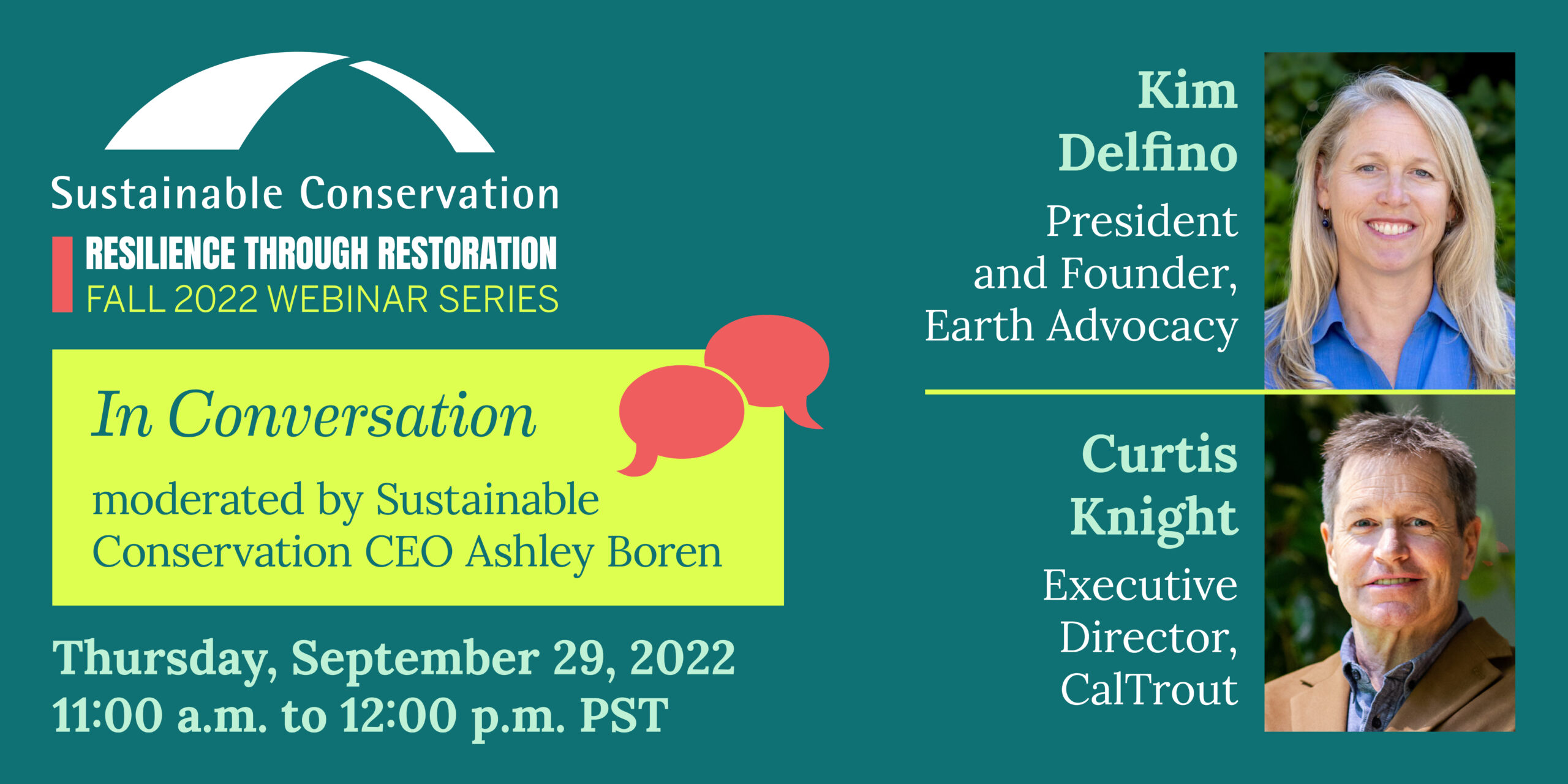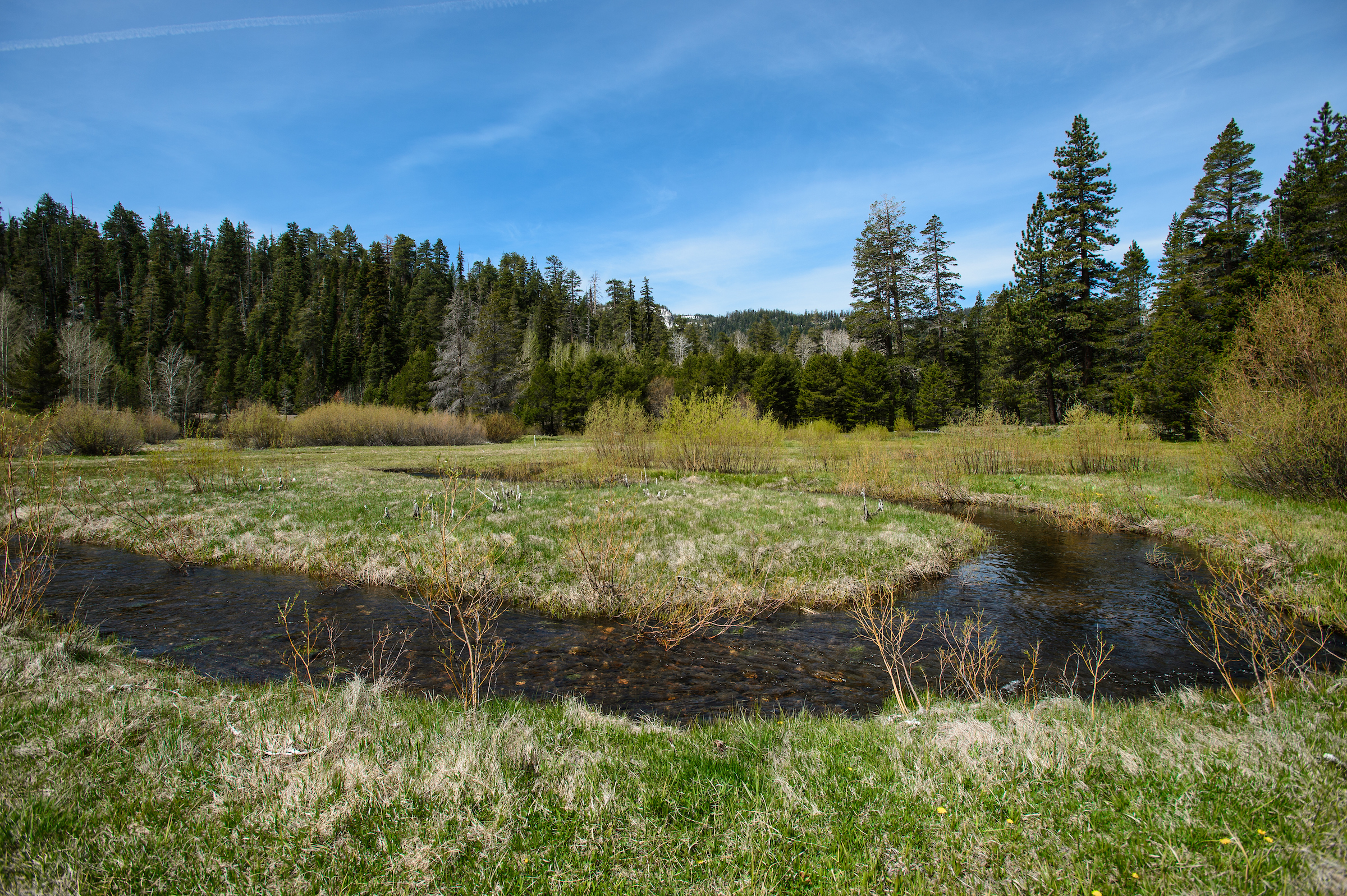
Missed the first webinar in our Resilience through Restoration series? We’ve got you covered with a recap of the event – and you can watch the full recording, too! Thanks to our generous webinar series sponsors ESA, The Foster, Holland & Knight, and Spottswoode Estate Vineyard and Winery.
Restoration for Climate Resilience
Sustainable Conservation Chief Executive Officer Ashley Boren moderated an excellent conversation between Kim Delfino, President and Founder of Earth Advocacy and long-time Sustainable Conservation board member, and Curtis Knight, Executive Director of CalTrout.
California’s species and people face a complex, mounting climate crisis. To build true resilience, we must accelerate the pace and scale of habitat restoration across our state.
As we celebrate a dual win with the State Water Resources Control Board and the U.S. Fish and Wildlife Service for restoration permitting and authorizations in California this past month, more opportunities are before us: increased state funding, time-tested partnerships, and a wealth of restoration efforts in progress to bolster our precious biodiversity, protect communities, reconnect people with recreation, and repair our riparian ecosystems.
Why do we need to accelerate the pace and scale of habitat restoration in California?
Delfino set the stage by citing that we’re at a true inflection point with nature, given our impacts and our current climate realities. She also noted that we as humans are not somehow separate from our environment. We’re part of our ecosystems, and human health is environmental health.
Our time to act is dwindling: with just 10% of our historic wetlands and 1-2% of our riparian areas left, we can’t just protect our untouched habitat. We have to actively restore these vital places in California.
Knight added that investments in our natural capital to combat drought and boost species diversity and resilience are critical now. Accelerating restoration means not just getting individual projects on the ground more quickly but changing the way we think about their scope and scale.

Sierra meadows soak up, hold, and release precipitation during our dry seasons, and are critical to our drought resilience and fire preparedness. Photo: Kelly M. Grow/California Department of Water Resources.
What are some of the benefits we’ll see if we do accelerate restoration?
In addition to restored floodplains, revitalized estuaries, and removed dams and other barriers, Knight elaborated on the amazing benefits of Sierra meadows. Restoring them means bolstering our water supplies in dry times, because meadows soak up snow runoff and precipitation, hold it, and release it over time. Functioning meadows are also fantastic firebreaks, sequester carbon, and reduce greenhouse gas emissions. The Sierra Meadows Partnership is a great organization that brings people together to restore these critical parts of our watersheds.
The panelists also covered capturing and storing precipitation as it shifts from snowpack to rain, riparian area restoration for fish habitat and flood protection, marsh restoration for coastal resilience, and even kelp forest restoration to mitigate wave action and slow coastal erosion.
For people, restoring access to nature is critical when we think about equity. Restoring creeks and river systems in the San Joaquin Valley, for example, allows recreation access and mitigates heat in communities. And, Knight added that if more people know about the restoration that’s happening in our backyards, we can learn more and get involved!
“People think of habitat or ecosystem restoration as primarily for animals, birds or fish, but it has incredible benefits for society and people. We are part of nature, but we sometimes think of ourselves as separate” – Ashley Boren
What are some things people can feel good and hopeful about? What is actually being done?
Delfino remarked that “crisis helps focus us,” and enumerated the Governor’s Office 30×30 initiative. She also made the critical point that it’s not just about protecting what’s intact, but restoring what’s degraded in California. With more money in our state budget thanks to our surplus, scaling restoration means we can take advantage of the funding when it’s available, and have an even bigger impact.
Knight also spoke of the Yurok and Karuk Tribes’ monumental efforts on the Klamath, and the statewide focus on examining and removing old infrastructure.
“It’s a moment in time. There’s a wave coming, and it’s really encouraging to see all this permitting work coming together right now. We need the big ideas on the ground and the partnerships to implement the work” – Curtis Knight
Authorizations and permits aren’t the only things we need to scale restoration. What else needs to be done, and what can we do?
Delfino notes more investment in science and monitoring to understand the landscape out there, so we know “what we’re restoring to, and what is possible.” We also need to staff up and create a workforce that’s capable of doing the on-the-ground work – and pay them a living wage.
Knight noted that the political cycle tends to drive urgency around immediate, tangible work, and we need more fluid funding to reflect the time and effort needed to design and implement projects. Science and active data collection is also critical to inform action & build trust.
Most importantly, people need to advocate for more focus and funding on restoration in California. This is a multi-generational effort, after all!
What’s Next?
Stick with us! Bringing people together is what we do, and we encourage you to visit our Check In & Connect page for access to all of our event recordings, and so you can catch up on any webinars you’ve missed. You can also check out our Twitter coverage of this event.
